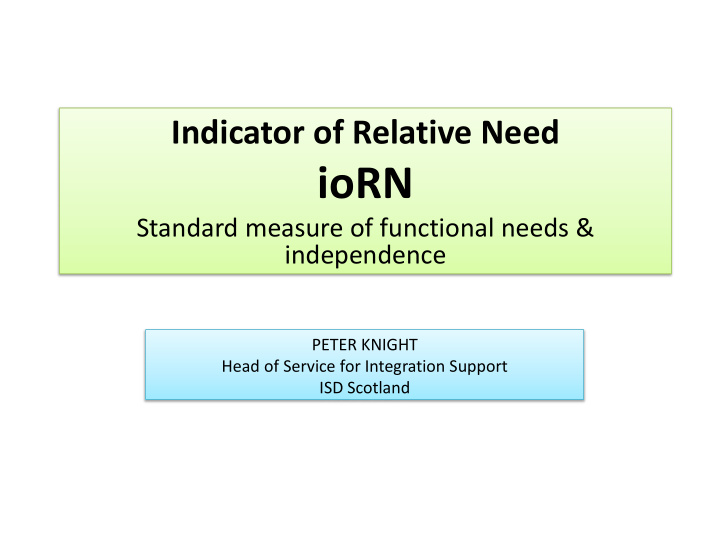



Indicator of Relative Need ioRN Standard measure of functional needs & independence PETER KNIGHT Head of Service for Integration Support ISD Scotland
Principles of integration of health and social care, include: o Best anticipate needs and prevent them arising o Take account of the particular needs of different service-users o Take account of the particular characteristics and circumstances of different service-users
ISD Scotland’s ‘Family tree’ ➢ SHRUGS (circa 1990) for ➢ SCRUGS (circa 1999) routine measurement of ➢ RUM/ioRN (circa 2002) functional need/status ➢ ioRN for care homes (circa 2008) ➢ ioRN2 for the community
Components of the ioRN2 • Standard questions & answer options • ioRN2 Algorithm Supported by: • Training pack (being finalised now) • Practitioner user resource pack • Guidance • Other resources on request
5 Community ioRN questions Minutes
Community ioRN: completion follows an outcome-focussed assessment Personal themes • Mobility, transferring and eating • Personal Care & Food Prep’n • Mental well-being, behaviour and risk
www.isdscotland.org/IoRN2
Features of ioRN2 data Person-centred Standardised & consistent Collectable by health and social care Shareable information Generates aggregate info
Example 1 - initial and review for ADL, personal care and food and drink questions (Q4 to Q10) and mental well being. ADL 4 Mental well being / Q4 Washing hands 3.5 Behaviour 3 and face 2.5 2 1.5 1 Q10 Hot drink Q7 Dressing 0.5 initial 0 Q9 Light snack Q5 Complete wash Note : ADL consists of: 1) eating a meal Q8 Main meal Q6 Wash hair 2) mobilising an transferring 3) using the toilet 10
Example 1 - initial and review for ADL, personal care and food and drink questions (Q4 to Q10) and mental well being. ADL 4 Mental well being / Q4 Washing hands 3.5 Behaviour 3 and face 2.5 2 1.5 1 Q10 Hot drink Q7 Dressing 0.5 initial 0 review Q9 Light snack Q5 Complete wash Note : ADL consists of: 1) eating a meal Q8 Main meal Q6 Wash hair 2) mobilising an transferring 3) using the toilet 11
Percentage distribution of ioRN groups by named team
Change in ioRN group: all teams sample are people who have two ioRN groups 40 35 30 % of total (N=693) 25 Initial 20 15 10 5 0 A1 A2 A3 B1 B2 B3 C+E D F H I ioRN2 group
Change in ioRN group: all teams sample are people who have two ioRN groups 40 35 30 Initial % of total (N=693) 25 Second 20 15 10 5 0 A1 A2 A3 B1 B2 B3 C+E D F H I ioRN2 group
Based on insight gained from an assessment About me Person-centred information Collectable across health, social care and housing Complements information on personal outcomes Provides information for a wide range of purposes Useful to practitioners...and to management
Estimated hours per week of informal care given by carers: cumulative percentages by ioRN Group; Clackmannanshire data 100% 90% 80% 70% 60% 35+ hrs 50% 20 - 34 hrs 40% 5 - 19 hrs 30% 1 - 4 hrs 20% 10% 0% A1+A2 A3 B1 B2 B3 C + E D F + G + H I ioRN Group
Common Tool, Common Language: Supporting Integration
ioRN2 development report (July 2017) ‘Outcomes Count’ With a Foreword by Scotland’s Chief Nursing Officer, Chief Social Work Adviser (to the SG), and Chief Health Professions Officer https://www.isdscotland.org/Health- Topics/Health-and-Social-Community- Care/Publications/2017-07-25/2017-07-25- IORN2-Report.pdf?40417116881 Or check webpage: http://www.isdscotland.org/Health- Topics/Health-and-Social-Community- Care/Dependency-Relative-Needs/In-the- Community/
Recommend
More recommend